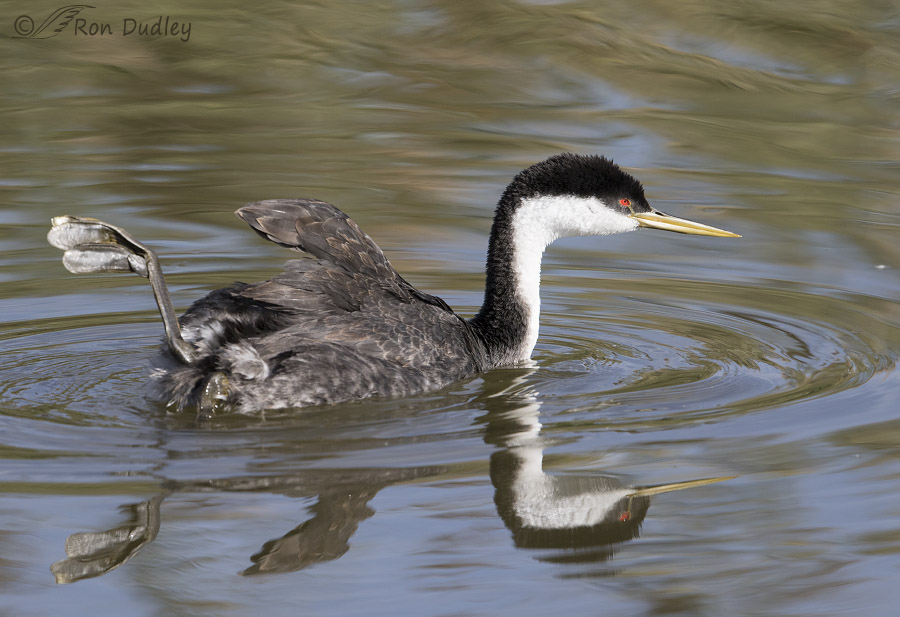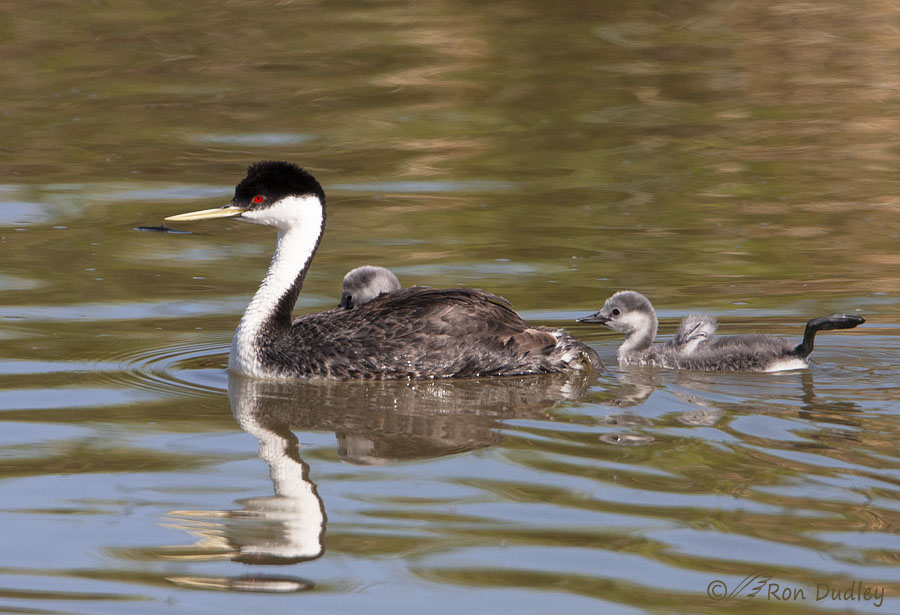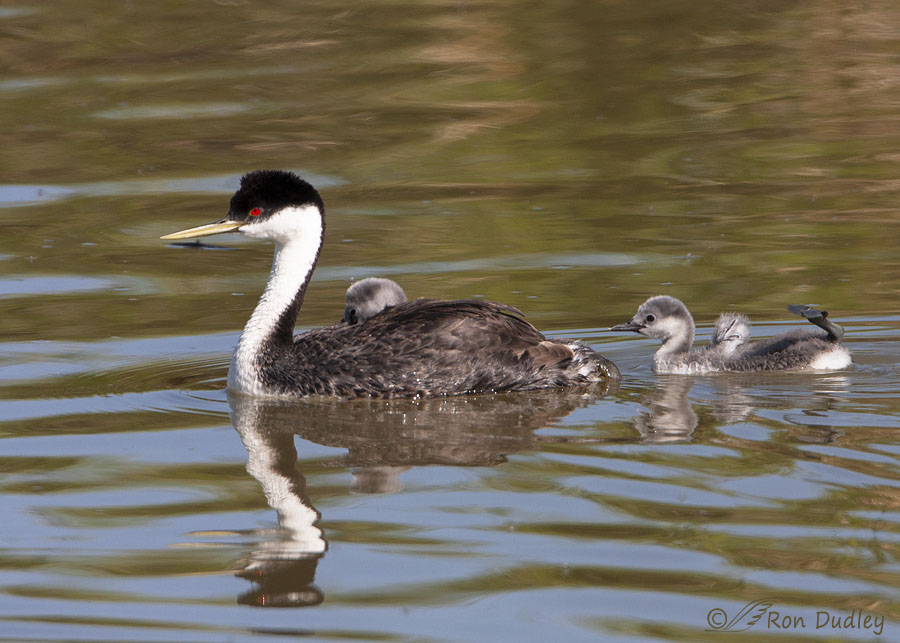So the behavior must be instinctive.
Western Grebes often raise a foot out of the water, shake off the water, and then store it under a wing and flank feathers in order to keep it warm and prevent heat loss from their huge foot that acts like a radiator. The behavior is sometimes called “foot shipping” (one definition of shipping is “to put in place for use”.)

That’s what’s happening here. The foot and leg are raised out of the water, shaken to get rid of excess water, and then one wing is raised before the foot is tucked under it and the wing folded against the body again – keeping that huge foot comfy, warm and dry under the wing.
Anyone who has spent significant time with Western Grebes has likely seen them do it, even though all you may have noticed is the foot-shaking because the rest of the behavior happens pretty fast and is often missed. Five years ago I published a blog post documenting and explaining the behavior in greater detail. If you have the interest that post can be seen here.
In today’s post I’ll document the same behavior in a very young Western Grebe chick, a chick so young it didn’t yet have all the ‘equipment’ necessary to accomplish the ultimate goal of the behavior – to store or “ship” the foot under its wing.

1/1250, f/9, ISO 400, Canon 40D, Canon EF500mm f/4L IS USM + 1.4 tc, not baited, set up or called in
Way back in July of 2009 I photographed this Western Grebe chick performing the behavior long before I knew what it was, or what it was meant to accomplish. Here he’s shaking ‘his’ foot and raising his tiny wing before…

1/1600, f/9, ISO 400, Canon 40D, Canon EF500mm f/4L IS USM + 1.4 tc, not baited, set up or called in
bringing his foot forward in a futile attempt to place it under his wing.
But at this age his wing was just a stubby (though cute) little appendage that was much too small to accommodate his foot so all he could do was lay his foot across his back and let it dry in the warming sun. For some reason I didn’t save any photos taken after this one so in this instance I can’t document him laying his foot across his back.
But I’ve seen it before in chicks this young so I’m confident that’s what happened.
Ron
PS – I’ve never posted these last two photos to my blog because I don’t much like that floating stick under the adult’s bill. But I can mostly ignore it when I’m documenting behavior.


I am so glad that you were able to ignore that floating stick – which I didn’t even see until you mentioned it. I do love your documentary series. Thank you. Muchly.
Appreciated muchly, EC. I can ignore quite a bit if there’s interesting behavior involved.
Fascinating! Thanks for the link to the earlier post, too.
They look like wind-up toys, or an Ikea project mid-assembly.
“or an Ikea project mid-assembly”
“Mid-assemply” – with Ikea’s stull that’s after about a week of trying!
Allow me to make a short list. You have provided insightful and informative posts on Western Grebes including the following:
Foot shipping
Back Brooding
Rushing and weed ceremonies
Nesting
Walking
Feather eating
Feeding behaviors, mating-related and otherwise
And many others. Wow. A unique life history of the Western Grebe that we wouldn’t be able to find anywhere else.
Interesting to see the list like that, Lyle. Obviously, I’ve spent a lot of time around grebes over the years. Maybe I need to get a life… 🙂
Fascinating. I’ve seen this in adults but I’ve not had the opportunity to spend much time around Western Grebes during the breedinng season so I have not seen this in chicks before. It does look odd the first time one sees it happen. Thanks for showing it to us in one so young.
I might add that this is similar to ducks, shorebirds and other birds who stand on one foot and turn the head backwards to tuck the beak under the feathers of the back. It is the bare areas where heat is lost so cover the beak with the back feathers and pull one foot up into the body feather mass. Then switch feet from time to time.
Thanks for making that point about ducks and other birds, Dan.
Love the second photo!
Thanks, Nancy.
Fascinating, that you caught, visually, evidence that a behavior is instinctive long before it could be functional. A long time ago, I remember seeing a photograph of a human fetus, in utero, sucking its thumb…the label to the picture speculated that the action was possibly instinctive “practice” for future
use.
Kris, if it’s the same photo I remember it was in Life Magazine.
Like Alison’s hokey pokey – remember that well. Very cute post with those cute little guys/gals trying to learn “foot shipping” a term I have never heard. Next time I see Western Grebes I will be paying more attention. So concentrated on the little guy’s foot that I never even noticed the floating stick.
“Next time I see Western Grebes I will be paying more attention.”
When you do, watch carefully, Everett. The foot goes under the wing very fast so it’s hard to notice. Photos help…
That floating stick could be made into Jaws! Lol. But that’s really adorable to see the chick trying to do big bird things. 🙂
That stick burned my butt, Arwen I actually remember seeing the grebes swimming toward it and thinking they’ll do something interested at exactly the wrong time. And that’s what happened.
You jinxed yourself!
Interesting/amusing/incredible that they can perform that maneuver! 🙂 Those feet are amazing – makes sense that they’d need to “warm up” now and then.
Thank you, Judy.
Very nice shots and thanks for the lesson Ron .. hope you’re doing well!!
I’m still here, Jerry!
Learning something new every day. Thanks Ron.
Good. Thanks, Michael.
This reminds me of that old primary school activity, “doing the hokey pokey…)
Memories!